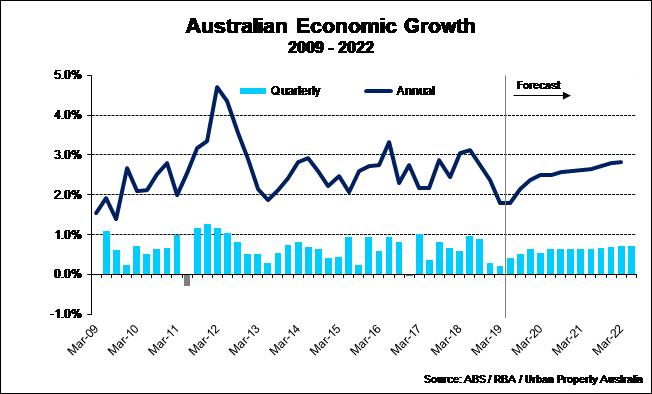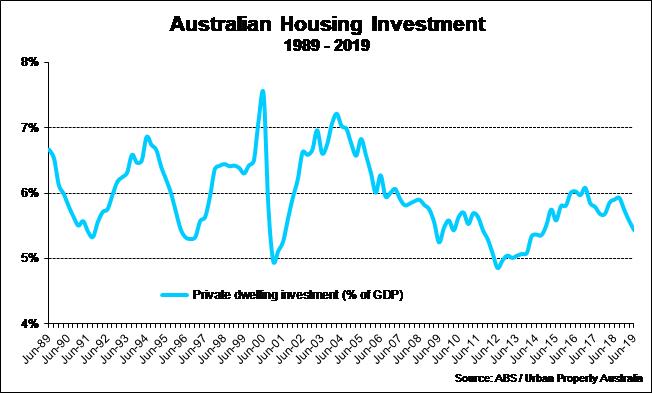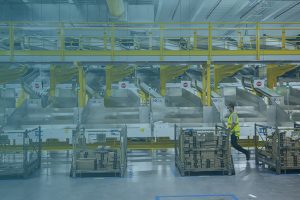Mid Year 2019 – Australian Economy
August 5th 2019 | , Urban Property Australia
- Growth in the Australian economy has slowed to its weakest expansion in 10 years
- In a bid to support economic growth, the Reserve Bank of Australia cut official interest rates to a new record low of 1.00% with further interest rate cuts are anticipated in 2019
- Consumption growth has slowed noticeably, impacted by modest income growth and a decreased wealth effect from falling home prices
Growth in the Australian economy has slowed and inflation remains low. Australia’s economy grew by 0.4% in the March 2019 quarter (the most recent available data), following the modest 0.2% increase in the December quarter. Over the year to March 2019, Australia’s economy grew by 1.8%, the weakest expansion since the September 2009 quarter. As was the case in the second half of last year, the main source of growth during the March quarter came from government spending, underpinned by the ongoing delivery of services in disability, health and aged care. Household consumption (the largest part of the Australian economy at around 60%) also remains weak, impacted by modest income growth and a decreased wealth effect from falling home prices in many parts of the country.

Looking ahead, growth momentum is unlikely to accelerate significantly through the rest of this year. The Australian economy is forecast to grow by 1.7% this year with growth not projected to rise above 2% per annum until 2020. Stronger growth in exports and projected work on new announced mining investment projects are expected to support growth.
In a bid to support economic growth, the Reserve Bank of Australia cut official interest rates by 25bps for a second consecutive month in July 2019 taking the cash rate to a new record low of 1.00%. Based on the outlook of slower growth and little constraint from inflation, further interest rate cuts are anticipated in 2019. In addition to the action in monetary policy, the Federal Government’s tax package was legislated in early July, locking in around $7.5billion of tax cuts in 2019/20.
Despite the Reserve Bank delivering successive months of lower borrowing costs and the Federal Parliament providing immediate tax relief, Australian consumer confidence has fallen to a two-year low. Similar to the consumer sector, having spiked after the Federal election result, Australia’s private sector is losing momentum, with business conditions falling below average and weakening further as at July 2019.

Consumption growth has slowed noticeably, especially for those discretionary items that tend to be correlated with housing conditions. Dwelling investment continued to decline in the first half of 2019. While the pipeline of construction work yet to be done in New South Wales and Victoria remains high, dwelling investment is still expected to decline significantly over the next couple of years given the weakness in pre-sales activity and sharp decline in building approvals since 2018.
Conditions in the established housing market also remain soft. Housing prices have continued to decline, although the pace of decline has eased recently. Some other indicators, including auction clearance rates, have improved a little since the end of last year, but generally point to continued soft conditions.

Despite the adjustment in the housing market and weak consumption growth, the labour market remains healthy, with ongoing strong employment growth. Over the year to June 2019, 296,000 new jobs were created across Australia, 53% above the 10-year average. Despite the solid employment growth, the unemployment rate of 5.2% remains well above the RBA’s current estimate of full employment, and higher than the 4.9% trough recorded in February 2019. Forward-looking indicators, such as job advertisements and employment intentions, suggest that growth in employment will moderate over coming months.
Australian private sector business investment fell unexpectedly in the first quarter of 2019, declining by 1.7%, to be now 1.9% lower over the year. While actual investment in 2019 to date has been disappointing, there is better news looking ahead with business investment intended in the 2019/20 financial year improved noticeably across several individual industries.
Infrastructure spending is concentrated on a number of large road and rail developments, many of which are located in Sydney and Melbourne. Major project activity is expected to continue to rise from the trough observed in 2014, reaching a peak of around $19 billion in 2021. The majority of future work will be concentrated in the rail sector, led by and the $12 billion second stage of the Sydney Metro and the $11 billion Melbourne Metro.
At a state level, the improving trend in final demand of the past few years appears to have has stalled with most states experiencing slower growth in 2019 to date. Overall growth generally remains solid, with all Australian states and territories recording growth in gross state product over the year with the exception of Northern Territory and Western Australia. Tasmania recorded the greatest growth, up 5.0% followed by ACT up 4.2% and Victoria (3.0%).
Copyright © 2019 by Urban Property Australia All rights reserved. No part of this publication may be reproduced in any form, by microfilm, xerography, electronically or otherwise, or incorporated into any information retrieval system, without the written permission of the copyright owner.



